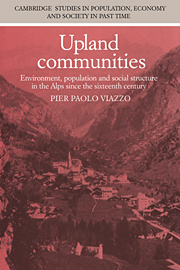 Upland Communities
Upland Communities Book contents
- Frontmatter
- Contents
- List of illustrations
- List of tables
- List of abbreviations
- Acknowledgements
- Introduction: anthropology, historical demography and the study of mountain societies
- 1 Environment, population and social structure: the Alpine village as an ecosystem
- 2 Open systems, open questions
- 3 Anthropologists in the Alps
- 4 The changing demography of Alpine communities
- 5 The traditional economy and its demise
- 6 The causes and consequences of Alpine emigration
- 7 The wealth from the earth: mining and immigration
- 8 Population, resources and homeostatic regulation
- 9 The domestic domain
- 10 Upland communities
- A summary of conclusions
- Bibliography
- Index
Introduction: anthropology, historical demography and the study of mountain societies
Published online by Cambridge University Press: 13 October 2009
- Frontmatter
- Contents
- List of illustrations
- List of tables
- List of abbreviations
- Acknowledgements
- Introduction: anthropology, historical demography and the study of mountain societies
- 1 Environment, population and social structure: the Alpine village as an ecosystem
- 2 Open systems, open questions
- 3 Anthropologists in the Alps
- 4 The changing demography of Alpine communities
- 5 The traditional economy and its demise
- 6 The causes and consequences of Alpine emigration
- 7 The wealth from the earth: mining and immigration
- 8 Population, resources and homeostatic regulation
- 9 The domestic domain
- 10 Upland communities
- A summary of conclusions
- Bibliography
- Index
Summary
The question of the relations between the physical environment and human social organization is a very old one. It has fascinated many generations of scholars and stirred up acrimonious debates. And in the course of these debates, as Lucien Febvre remarked in his Geographical introduction to history, the advocates of environmental primacy have constantly placed a strong emphasis on ‘the influence of mountains on man, and the special characters which they imprint on mountain societies – characters in every respect dissimilar to those of societies on the plains, being affected by a natural environment peculiarly oppressive and tyrannical’.
This was particularly the case in the late nineteenth and early twentieth centuries, when the laudable attempt to counteract the dangers of racial determinism led some of the pioneers of human geography to espouse a no less extreme form of environmental determinism. The method associated with the names of Friedrich Ratzel and Ellen C. Semple consisted in comparing peoples of different ethnic stocks but living under analogous geographical conditions. If these peoples were found to display similar social and economic features, then it seemed legitimate to infer that such similarities were due to environment rather than to race. The fact that similarities in economic and social organization appeared to be especially marked in mountain areas was taken as evidence that virtually no alternative was available to people inhabiting regions in which the beauty of nature belies extraordinarily difficult living conditions.
- Type
- Chapter
- Information
- Upland CommunitiesEnvironment, Population and Social Structure in the Alps since the Sixteenth Century, pp. 1 - 15Publisher: Cambridge University PressPrint publication year: 1989


